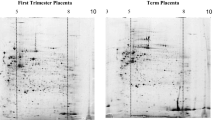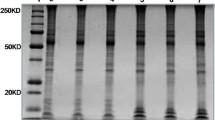Abstract
Characterizing the protein factors released from placentae during pathogenesis remains a key objective toward understanding preeclampsia and related pregnancy disorders. Gel-free proteomics technologies applied to placental explant-conditioned media offers the potential of identifying these factors. Relative quantification mass spectrometry using isobaric tagging for relative and absolute quantification (iTRAQ) labeling was employed to compare the “secretome” between healthy term placental tissue cultured under both normoxic and hypoxic oxygen tensions. Of the 499 proteins identified, 45 were differentially expressed (P < .01 level), including interleukin 8 (IL-8) which was significantly upregulated under hypoxia. Global protein level changes are suggestive of decreased extracellular matrix remodeling under the same conditions. A significant enrichment of soluble liberated placental factors is achieved using this model system. Identifying these changes resulting from hypoxic conditioning is hypothesis generating and may provide new mechanistic insights into preeclampsia.
Similar content being viewed by others
References
Crews JK, Herrington JN, Granger JP, Khalil RA. Decreased endothelium-dependent vascular relaxation during reduction of uterine perfusion pressure in pregnant rat. Hypertension. 2000;35(1 pt 2):367–372.
Roberts JM, Taylor RN, Musci TJ, Rodgers GM, Hubel CA, McLaughlin MK. Preeclampsia: an endothelial cell disorder. Am J Obstet Gynecol. 1989;161(5):1200–1204.
Thomson NF, Thornton S, Clark JF. The effects of placental extracts from normotensive and preeclamptic women on vasoconstriction and oxidative metabolism. Am J Obstet Gynecol. 2000;183(1):206–210.
Rajakumar A, Brandon HM, Daftary A, Ness R, Conrad KP. Evidence for the functional activity of hypoxia-inducible transcription factors overexpressed in preeclamptic placentae. Placenta. 2004;25(10):763–769.
Hayman R, Warren A, Brockelsby J, Johnson I, Baker P. Plasma from women with pre-eclampsia induces an in vitro alteration in the endothelium-dependent behaviour of myometrial resistance arteries. BJOG. 2000;107(1):108–15.
Myers J, Mires G, Macleod M, Baker P. In preeclampsia, the circulating factors capable of altering in vitro endothelial function precede clinical disease. Hypertension. 2005;45(2):258–263.
Hayman R, Warren A, Johnson I, Baker P. The preliminary characterization of a vasoactive circulating factor(s) in pree-clampsia. Am J Obstet Gynecol. 2001;184(6):1196–1203.
Myers JE, Hart S, Armstrong S, et al. Evidence for multiple circulating factors in preeclampsia. Am J Obstet Gynecol. 2007;196(3):266 e1–e6.
Chappell L, Bewley S. Pre-eclamptic toxaemia: the role of uterine artery Doppler. Br J Obstet Gynaecol. 1998;105(4):379–382.
Robinson NJ, Wareing M, Hudson NK, et al. Oxygen and the liberation of placental factors responsible for vascular compromise. Lab Invest. 2008;88(3):293–305.
Keshamouni VG, Michailidis G, Grasso CS, et al. Differential protein expression profiling by iTRAQ-2DLC-MS/MS of lung cancer cells undergoing epithelial-mesenchymal transition reveals a migratory/invasive phenotype. J Proteome Res. 2006;5(5):1143–1154.
Pierce A, Unwin RD, Evans CA, et al. Eight-channel iTRAQ enables comparison of the activity of 6 leukaemogenic tyrosine kinases. Mol Cell Proteomics. 2008;7(5):853–863.
Sui J, Zhang J, Tan TL, Ching CB, Chen WN. Comparative proteomic analysis of vascular smooth muscle cells incubated with S- and R-enantiomers of atenolol using iTRAQ-coupled 2D LC-MS/MS. Mol Cell Proteomics. 2008;7(6):1007–1018.
Yang Y, Zhang S, Howe K, et al. A comparison of nLC-ESI-MS/MS and nLC-MALDI-MS/MS for GeLC-based protein identification and iTRAQ-based shotgun quantitative proteomics. J Biomol Tech. 2007;18(4):226–237.
Daayana S, Baker P, Crocker I. An image analysis technique for the investigation of variations in placental morphology in pregnancies complicated by preeclampsia with and without intrauterine growth restriction. J Soc Gynecol Investig. 2004; 11(8):545–552.
Shilov IV, Seymour SL, Patel AA, et al. The Paragon Algorithm, a next generation search engine that uses sequence temperature values and feature probabilities to identify peptides from tandem mass spectra. Mol Cell Proteomics. 2007;6(9): 1638–1655.
Mi H, Lazareva-Ulitsky B, Loo R, et al. The PANTHER database of protein families, subfamilies, functions and pathways. Nucleic Acids Res. 2005;33(Database issue):D284–D288.
Thomas PD, Campbell MJ, Kejariwal A, et al. PANTHER: a library of protein families and subfamilies indexed by function. Genome Res. 2003;13(9):2129–2141.
Robinson JM, Ackerman WE 4th, Kniss DA, Takizawa T, Vandre DD. Proteomics of the human placenta: promises and realities. Placenta. 2008;29(2):135–143.
Chen CP, Aplin JD. Placental extracellular matrix: gene expression, deposition by placental fibroblasts and the effect of oxygen. Placenta. 2003;24(4):316–325.
Chen CP, Yang YC, Su TH, Chen CY, Aplin JD. Hypoxia and transforming growth factor-beta 1 act independently to increase extracellular matrix production by placental fibroblasts. J Clin Endocrinol Metab. 2005;90(2):1083–1090.
Rahat MA, Marom B, Bitterman H, Weiss-Cerem L, Kinarty A, Lahat N. Hypoxia reduces the output of matrix metalloproteinase-9 (MMP-9) in monocytes by inhibiting its secretion and elevating membranal association. J Leukoc Biol. 2006;79(4):706–718.
Zhao W, Darmanin S, Fu Q, et al. Hypoxia suppresses the production of matrix metalloproteinases and the migration of human monocyte-derived dendritic cells. Eur J Immunol. 2005;35(12):3468–3477.
Fox H. Pathology of the placenta. Clin Obstet Gynaecol. 1986; 13(3):501–519.
Hu R, Jin H, Zhou S, Yang P, Li X. Proteomic analysis of hypoxia-induced responses in the syncytialization of human placental cell line BeWo. Placenta. 2007;28(5–6):399–407.
Hoang VM, Foulk R, Clauser K, Burlingame A, Gibson BW, Fisher SJ. Functional proteomics: examining the effects of hypoxia on the cytotrophoblast protein repertoire. Biochemistry. 2001;40(13):4077–4086.
Bowen RS, Gu Y, Zhang Y, Lewis DF, Wang Y. Hypoxia promotes interleukin-6 and -8 but reduces interleukin-10 production by placental trophoblast cells from preeclamptic pregnancies. J Soc Gynecol Investig. 2005;12(6):428–432.
Jonsson Y, Ruber M, Matthiesen L, et al. Cytokine mapping of sera from women with preeclampsia and normal pregnancies. J Reprod Immunol. 2006;70(1–2):83–91.
Author information
Authors and Affiliations
Corresponding author
Rights and permissions
About this article
Cite this article
Blankley, R.T., Robinson, N.J., Aplin, J.D. et al. A Gel-Free Quantitative Proteomics Analysis of Factors Released From Hypoxic-Conditioned Placentae. Reprod. Sci. 17, 247–257 (2010). https://doi.org/10.1177/1933719109351320
Published:
Issue Date:
DOI: https://doi.org/10.1177/1933719109351320




